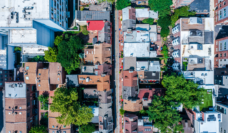Gun deaths in the U.S., over 48,000 in 2021, are mostly attributed to suicide and community gun violence. ‘Gang-related’ violence, a subset of community gun violence, accounts for one-tenth of all firearm homicides in the country. When shots are fired, they most often cause harm in historically under-resourced Black and Brown communities. The insidious effects of community violence bleed into all parts of the community—trauma extends from people (mostly youth) who have caused or experienced violence, to their families, and to those living in neighborhoods with frequent violent activity from what they witness.
To prevent the spread of gun-related injury and death, community violence interventions (CVI) have attempted to offset traditional, punitive law enforcement methods. Streetwork programs are one type of CVI strategy that uses neighborhood-based workers to offer violence mediation and social services to residents in areas at high risk for violence, especially areas with heavy gang activity. These programs have emerged as a leading option for violence prevention that sidestep the potential for over policing.
David M. Hureau and colleagues closely examined the effects of a streetwork program, using StreetSafe Boston as a model. StreetSafe Boston, an intervention that provided violence mediation and social services to 20 gangs across the city, worked to disrupt and reduce instances of retaliatory gun violence from its inception in 2009 until its closure in 2014.
Streetworkers used their knowledge of gangs (often through lived experience) to predict and prevent violence. Each team member was assigned to a gang and responded whenever a violent incident occurred. As respected members of their communities, streetworkers looked for signs of growing hostility, helped de-escalate tensions at a shooting scene or in a hospital emergency room, and worked to establish safety plans for individuals in risky situations (i.e., either facing retaliation or vulnerable to victimization). The trust established between streetworkers and individuals in gangs helped to identify longer-term goals beyond cycles of conflict, like getting a GED, a driver’s license, or finding transitional employment.
Community bonds are essential for reducing trauma and breaking the cycle of violence.
Researchers recorded annual counts of total shootings and gang-related shootings from 2006 to 2013, three years before and four years after the initiation of StreetSafe Boston. Comparing the years before and after the program launch, the average number of shootings per year decreased 20 percent for all shootings and decreased 25 percent for gang shootings. StreetSafe Boston began during a time of declining gun violence in Boston, with the sharpest period of decline seen around the start of the program’s first year (2009-2010).
Despite a widespread presence throughout the community, StreetSafe Boston was unable to sustain its ambitious long-term goals of reducing shootings by 60% and homicides by 30% in neighborhoods with the most violence, and the program was shut down.
Joshua Wakeham highlighted factors that led to the program’s ending. He found that The Boston Foundation, the organization that originally funded StreetSafe Boston, had differing visions and bureaucratic goals that were hard to maintain for the streetwork team. Those working in the neighborhoods with gangs were focused on slow behavioral changes based on trust and relationship-building, rather than measuring trackable data.
This evaluation emphasizes the need to carefully measure outcomes in program design, while still recognizing the impacts and effectiveness of streetwork strategy. New paths have already been forged. Last spring, Mayor Wu’s office partnered with the University of Maryland in a gun violence reduction initiative, which will involve streetwork programming. Meanwhile, rising organizations like Uncornered and Training Center for Excellence (TC4E) are similarly incorporating data with resources and support to reach out directly to those touched by violence.
Community bonds are essential for reducing trauma and breaking the cycle of violence. Even when challenged by the scope of their work, streetwork teams can bring a strong sense of well-being and healing to communities deeply affected by the wounds of gang violence.
Photo via Getty Images














